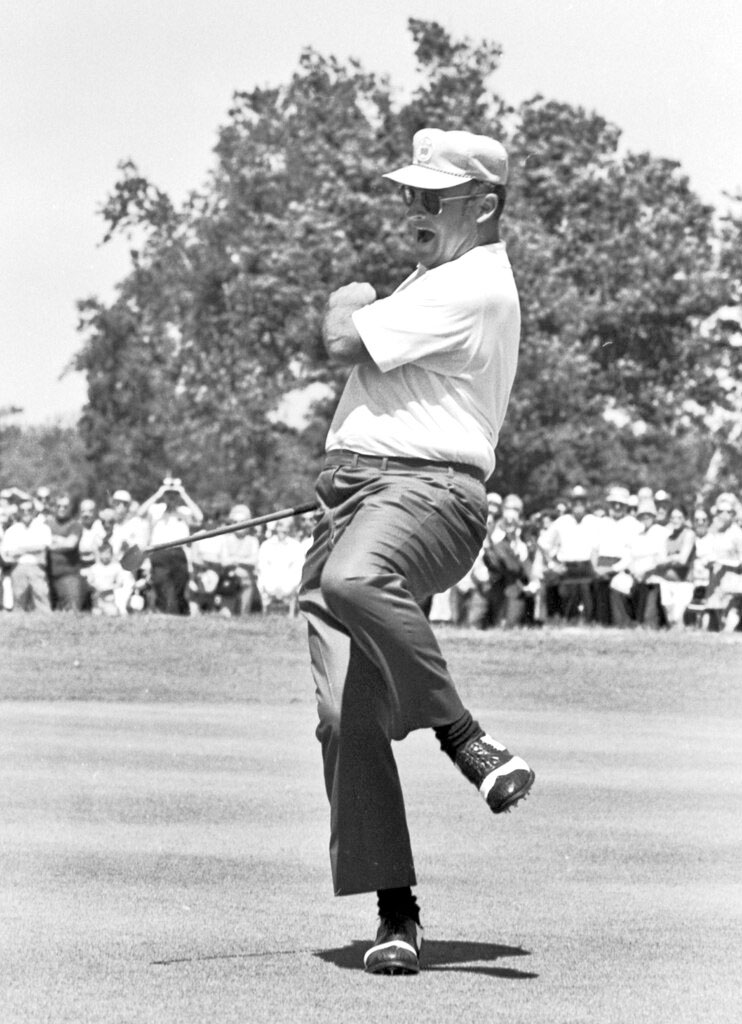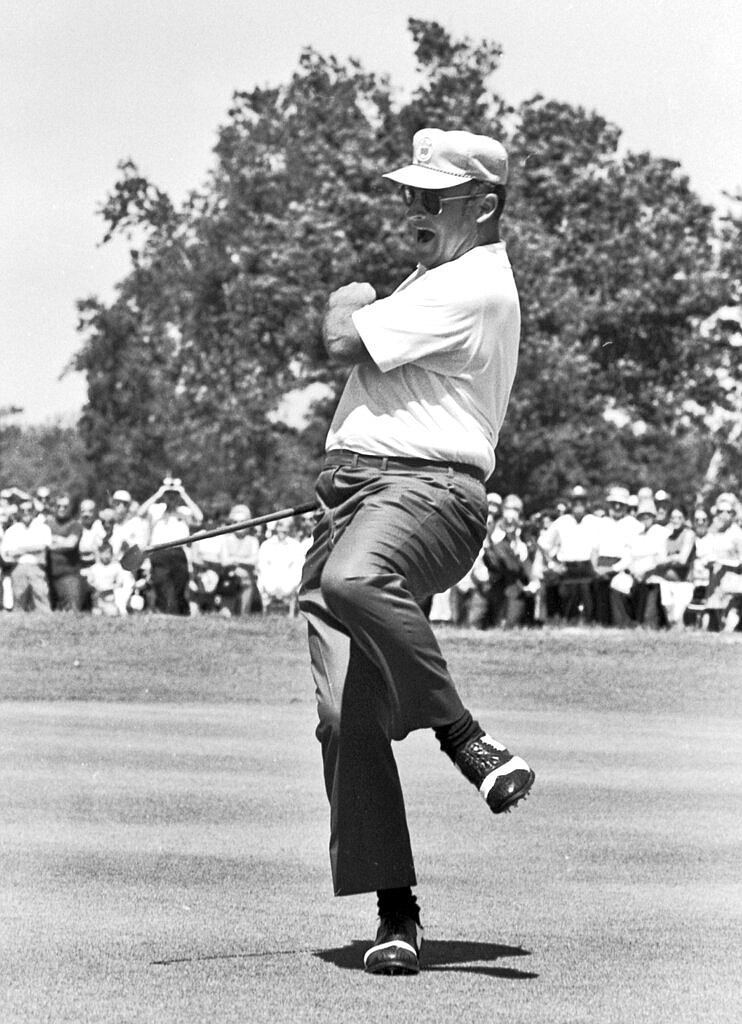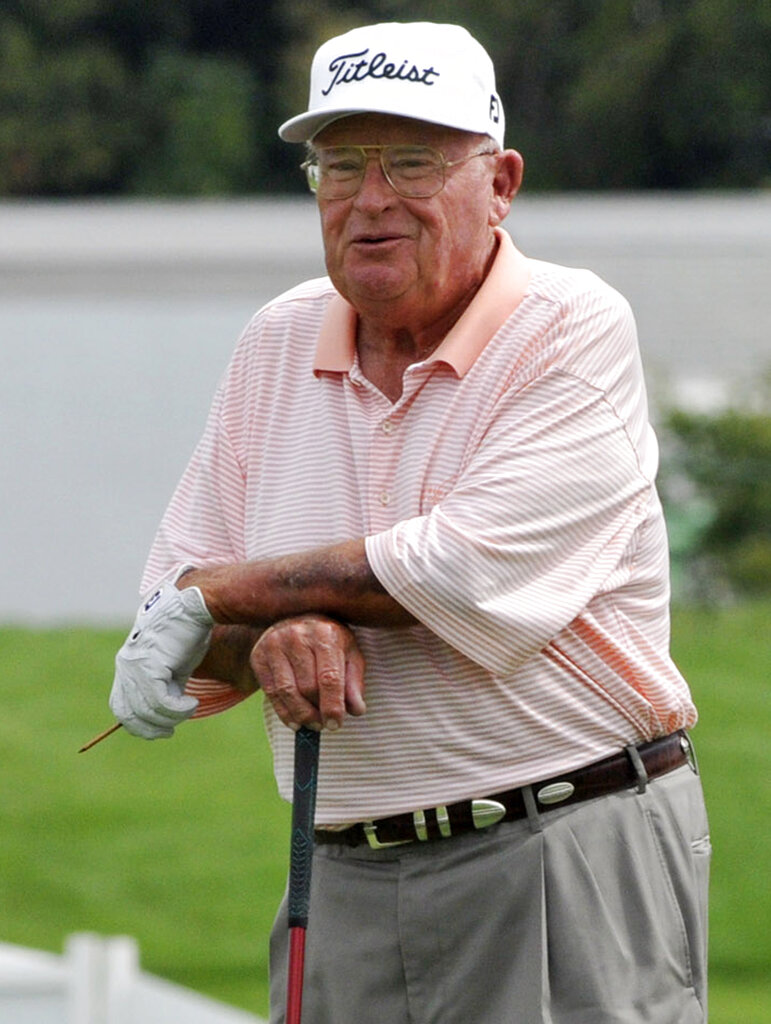Miller Barber was no one's ideal of a professional golfer. An East Texan with a twang and a folksy manner, he was pudgy, suffered from hay fever and wore large prescription dark glasses that gave him a somewhat mysterious look.
He stood at 5-foot-11 and 200-something pounds, although he didn't give a specific figure over the 200-pound mark.
That image was enhanced by the fact that early in his career, Barber, then a bachelor reputed to have girlfriends in many of the PGA Tour stops, would disappear in the evenings, a practice that led his fellow pros to anoint him "Mr. X."
Barber's story is one of the last of old-school perseverance. Miller Westford Barber Jr. was born on March 31, 1931, in Shreveport, Louisiana, to Miller Westford Barber and Susie Mae Lawrence Barber. He was an only child. His parents split three years later, and his mother, Susie Mae, and his grandmother, Kitty, raised him. The whole family worked in the famous Bryce's Cafeteria in downtown Texarkana.
Bryce, Susie Mae's brother, was off at the war, and the women were keeping the home fries burning. When he got a little older, Barber helped out, preparing vegetables, busing dishes and bringing out food trays. He recalls an occasional celebrity coming in for lunch at Bryce's. Gene Autry and Orson Welles were two.
Barber earned money for his first golf lessons at age 13 by preparing vegetables for troop trains passing through to the West Coast.
Golf was just something Barber picked up. He could play during the day, as long as he made it on his bicycle to Bryce's by 8 p.m. to escort his mother home. Because it was wartime, his golf bag was nothing more than shellacked cardboard. Late at night, he and his buddies would dive in a lake to retrieve golf balls at a local country club. One night the club manager caught them and sentenced them to a month of swabbing toilets.
Nelson's influence
PGA legend Byron Nelson had a big influence on Barber's early career. Nelson was working as a golf pro at Texarkana Country Club when he met his future wife, Louise Shofner, to whom he was married for 50 years before she died in 1985. Snofner's family was from Texarkana, so Nelson would come to town to practice for the Masters in Augustus, Georgia.
Barber would caddie for Nelson, a mission so important that Miller would wash his tennis shoes for the occasion. The first time he worked for Nelson, Barber took the shag bag and stood out in a field about 100 yards down range. Nelson's first shot hit the bill of Barber's cap. Nelson started waving Barber to come in. When the boy was within earshot, Nelson told him not to stand by the shag bag. That was his target.
"One day he played 18 holes and hit the pin 10 times with shots," Barber says. "I'll never forget that as long as I live."
Woo Pig Sooie!
Barber grew up in Texarkana, a town divided by the Texas-Arkansas border that is marked by different colored bricks running down the center of State Line Avenue.
"You can have one foot in Texas and the other in Arkansas," Barber used to brag to his fellow golfers.
Shortly after graduating from Texas High, Barber enrolled at Texas A&M in College Station, Texas, to satisfy Susie Mae and Kitty, who thought the military atmosphere would be beneficial to him. It wasn't a good fit for the easy-going Barber, who promptly transferred to the University of Arkansas in Fayetteville.
He played on the Razorbacks' golf team, but back then there wasn't such a thing as a golf scholarship, so he was listed on the football roster. He even thought about playing running back. Pat Summerall, the television announcer and former NFL star, played for Arkansas at the time.
As Summerall puts it, "This guy got wiped out on one play and came back to the huddle peering through an earhole of his helmet. He said, 'I gotta find me another (blank) game.' "
That was the last time Barber scrimmaged.
Barber lettered in golf two years 1953 and 1954 at Arkansas.
After college, Barber, an ROTC guy, wound up in the U.S. Air Force stationed at Sherman, Texas. One of his friends there was Herb Somers, who went on to become a gynecologist in Philadelphia. "Miller was still the same guy he was back then," recalls Somers. "He loved life."
When Somers used to call his old buddy, he would yell into the phone, "Suuuu-eeee!" giving the Arkansas yell. "How 'bout them Hogs?" Barber would yell back.
After spending four years in the U.S. Air Force, Barber then turned golf pro in 1958. He played the PGA Tour with little success, but after a stint as head pro at the Apawamis Club in New York, he lit out on the tour again and won his first title at the Cajun Classic Open Invitational in 1964.
Unusual swing
Barber quickly became famous for his unusual swing. His right elbow flew outward on his backswing as he had raised the club to the outside, brought it high over his head, the shaft had almost perpendicular to the ground. After that, he looped the clubhead inside and he produced an orthodox downswing.
In an interview with a Florida newspaper, Barber said that when he was young he tried to get more conventional with the way he had swung a golf club. It was a total disaster. He just could not swing like Jack Nicklaus or Sam Snead, Barber admitted.
His ungainly swing aside, Barber was fighting the odds every time he walked on a course. He carried a large satchel -- "my shaving kit" -- that contains all the tablets, capsules and sprays needed to control his sneezing, watering eyes and running nose.
"I'm just runnin' like a faucet, like a faucet," Barber always said whenever anyone asked him how he was feeling.
"He probably lost a lot of tournaments because of the hay fever," says Bob Rosburg, an former pro golfer who became a TV announcer.
"One year he was tied for the lead at Orlando (Florida) and he started sneezing on the 72nd tee," Rosburg said. "He grabbed a pill -- his last one -- and when he went to take it, he sneezed again and it popped up in the air and fell into a lake. Now he was really stuck. He topped his tee shot, bogeyed the hole and lost the tournament by a shot."
As the years passed, Barber's biggest disappointment was his failure to win a major title. He came closest at the 1969 U.S. Open at the Champions Golf Club in Houston. Barber took a three-stroke lead into the final round, but faded to a 78. That same year, Barber finished seventh at the Masters, tied for fifth at the PGA and was 10th at the British Open.
"Never won a major. That's like a baseball player who can't hit in October," Barber said. "I had my chances. I could've won 'em all."
Barber also was a member of two U.S. Ryder Cup teams alongside such luminaries as Jack Nicklaus, Lee Trevino and Billy Casper. Overall, he won 11 PGA Tour events, the last one coming in 1978 at the Phoenix Open.
Senior Tour rebirth
While he had a storied career on the PGA Tour, he experienced a professional rebirth when he moved to the fledgling Senior Tour (for players 50 and older) in 1981. He won his first title in June and added two others before the season was over. He ultimately would win five Senior majors; three Senior Opens, in 1982, 1984, and 1985; a Senior PGA title in 1981; and the Senior Players Championship in 1983. His final win in 1989 gave him a total of 24 Senior Tour victories.
He accumulated more than $5.6 million in career earnings on 1,297 total starts on the PGA and Senior Tours, a total that was, at the time of his death, an all-time record.
The PGA Tour became Barber's home address; he almost never took a week off. When he wasn't playing, he holed up in the Ramada Inn in Sherman, paying by the week. From the end of 1964 through 1978, Barber won 11 tournaments. Arnold Palmer, who's 18 months older, won 16 during the same period, not counting three team championships with Nicklaus.
But while Arnie and his "Army supporters" were buzzing the courses on Sunday evenings in his jet, Barber would be loading up the car and heading for an Interstate highway. Counting his pennies, he'd drive to tournaments while popular players like Palmer and Nicklaus were flying to events.
Barber is a member of the University of Arkansas Sports Hall of Fame, and Arkansas Golf Hall of Fame, and Texas Golf Hall of Fame and Texas Sports Hall of Fame.
Barber married at the age of 39; he and his wife, Karen Barber, were married for 43 years until his death. The couple had five sons, including three from Karen's previous marriage.
While suffering from lymphoma stomach cancer and in hospice care in Scottsdale, Arizona, the last phone call Barber received came from golf icon Nicklaus, who was checking on his one-time Ryder Cup teammate. The call was said to have made Barber smile, one of his sons claimed.
Barber died three hours later, on June 11, 2013. He was 82 years old.
 FILE - In this April 20, 1970, file photo, Miller Barber lets out a yowl after sinking a 12-foot birdie putt on the second hole of a sudden-death playoff to win the New Orleans Open golf tournament in New Orleans. Barber, the unique-swinging golfer who made the most combined starts on the PGA and Champions tours, died Tuesday, June 11, 2013, the PGA said on Wednesday. He was 82. (AP Photo/File)
FILE - In this April 20, 1970, file photo, Miller Barber lets out a yowl after sinking a 12-foot birdie putt on the second hole of a sudden-death playoff to win the New Orleans Open golf tournament in New Orleans. Barber, the unique-swinging golfer who made the most combined starts on the PGA and Champions tours, died Tuesday, June 11, 2013, the PGA said on Wednesday. He was 82. (AP Photo/File) FILE - In this Aug. 7, 2010, file photo, Miller Barber waits to tee off during the Legends of Golf Challenge in Blaine, Minn. Barber, the unique-swinging golfer who made the most combined starts on the PGA and Champions tours, died Tuesday, June 11, 2013, the PGA said on Wednesday. He was 82. (AP Photo/Jim Mone, File)
FILE - In this Aug. 7, 2010, file photo, Miller Barber waits to tee off during the Legends of Golf Challenge in Blaine, Minn. Barber, the unique-swinging golfer who made the most combined starts on the PGA and Champions tours, died Tuesday, June 11, 2013, the PGA said on Wednesday. He was 82. (AP Photo/Jim Mone, File)

